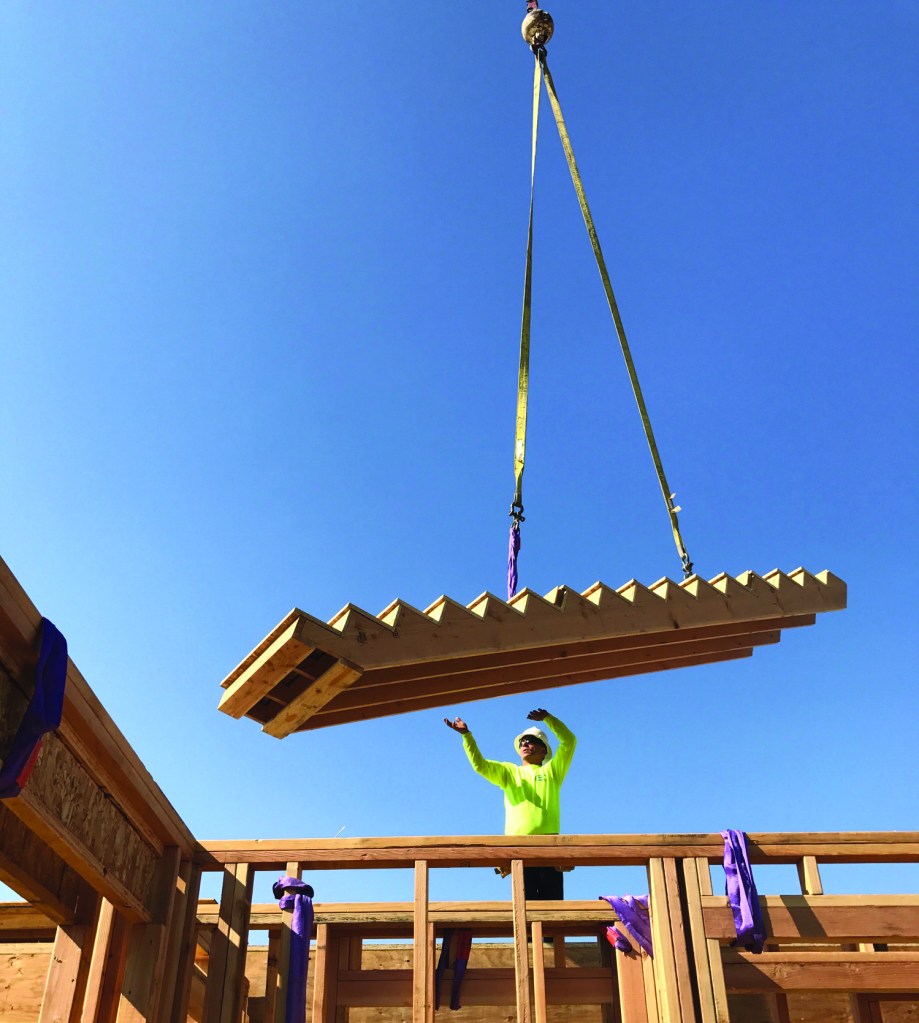Lumber and labor are perennial woes for most builders. Lumber price instability complicates revenue and profit forecasting, while the dearth of skilled workers has been blamed for everything from the inability to keep up with demand to rising warranty costs.
Responses to both issues should include rethinking how we frame houses. To start with, builders could dampen the effects of price fluctuations and protect their margins by better managing lumber use and by using more engineered components—neither of which actions asks them to alter how they build. Over the long-term, however, the better solution may be a transition to off-site building, a strategy that some progressive builders across the country are already employing.
Optimizing Materials
Lumber prices have gotten a lot of press lately. For instance, on September 19, Bloomberg.com reported that lumber futures had risen 16% since January, fueled by a U.S.–Canada trade dispute and wildfires that have been burning through Northwest timberlands. But how big a deal are these price trends?
Mike Wisnefski, a Chicago-based trader in lumber futures, believes that even if the current trade dispute resolves as a 20% tariff on Canadian lumber, retail prices won’t rise more than 5%. That’s because lumber markets are global. “If lumber goes to more than $450 per 1,000 board feet, as it did earlier this year, supply from other countries will prevent it from going higher,” he says.
Other industry watchers point out that the impact of past price increases on housing starts have been minimal. “The framing lumber for a $300,000 house might cost $15,000, so builders aren’t calling off projects just because of lumber price increases,” says Matt Layman, publisher of Layman’s Lumber Guide, a pricing newsletter for material suppliers. He believes builders will pay as much as $100 more per 1,000 board feet for spruce 2x4s to avoid using southern yellow pine.
That’s not to say the price of lumber isn’t an issue. The builders who most easily absorb any price increases are the ones who use lumber the most efficiently. In fact, construction waste may be costing some builders more than they know. Clark Ellis, CEO and founder of Continuum Advisory Group, a management consultancy based in Raleigh, N.C, says his team analyzed hundreds of house plans from several divisions of the nation’s top builders.
Ellis found that many builders were spending $2,000 to $4,000 more per home than necessary. “Material takeoffs are rounded up to the next highest number, then padded with generous waste factors. Inaccurate deliveries aren’t identified as such and materials get used inefficiently, so the builder has to order more to make up the shortfall,” he says. While these numbers include all materials, he sees the most waste in framing and siding. The causes include the following:
Sloppy takeoffs. “Most builders don’t know exactly how much of what materials go into their homes,” says Ellis. In particular, relying on suppliers for takeoffs often results in inaccurate shipments that have to be augmented later, making it difficult for the builder to get an accurate handle on costs.
Waste acceptance. Some trade contractors routinely add a 10% or 15% waste factor after rounding the takeoff up to the next highest number.
Stressed superintendents. With skilled job supervisors in short supply, those who are employed have more responsibilities than ever. They lack the time to verify deliveries or the experience to question field purchase orders from trade contractors who failed to do accurate takeoffs.
Lumber poaching. Framers who run short on sticks will often “borrow” from the next house in the development, leaving that one short. The practice can have a domino effect as the community is built out.
Poor tracking. “Many builders lack a system for ensuring that unused materials get returned and credited,” Ellis says. Field supervisors may see this as an accounting issue, but the accountants can track down a missing credit only if someone notifies them of the return.
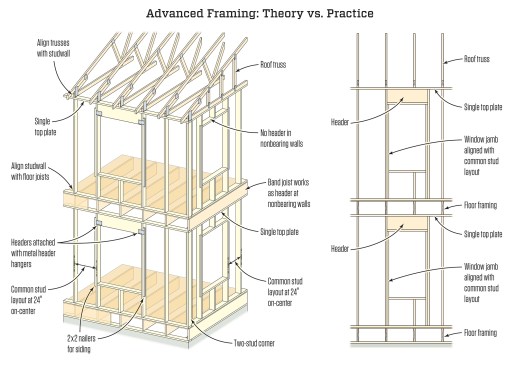
Tim Healey
The ‘Advanced Framing’ Promise
One of the most well known ways to build higher-quality homes for less money is through the use of advanced framing, also known as optimum value engineering (OVE). Developed in the 1970s by the NAHB Research Center (now Home Innovation Research Labs), OVE was conceived as a way to reduce the number of framing members used without compromising structural integrity. But since eliminating framing also somewhat reduces thermal bridging, advanced framing has become a tactic employed by builders to enhance energy efficiency, especially on homes with non-insulating sheathing.
Some builders have made advanced framing an important part of their business. “Our focus on energy efficiency has led us to a different framing approach than the typical builder by using advanced framing techniques,” says Todd Usher, president of Addison Homes, a design–build company in Greenville, N.C. This approach requires a higher level of care. To make it work, Addison has all plans checked by a structural engineer and provides detailed instructions to the company’s framing crews. Usher estimates a savings of about $1,500 per house in materials. That’s thanks to a more efficient frame as well as to less waste. “When we let the framer figure out what to do, it wasn’t uncommon to have full lengths of LVL left at the end of the job that we couldn’t return because they had been lying outside in the dirt.”
The approach isn’t for every builder, says Massachusetts high-performance builder David Joyce, who has been building advanced-frame homes for years. But he believes builders can realize some cost savings and make their homes more energy efficient by adopting some advanced framing details, including two-stud corners, ladder-framed wall intersections, and 24-inch stud spacing.
That 24-inch spacing gets some builders worried about wavy drywall. That’s why Austin, Texas-based builder Matt Risinger uses 5/8-inch drywall on 24-inch framed walls. “It’s stiffer, makes for a straighter wall, and looks better when finished,” he says. The extra mass also makes the finished house quieter.
Joyce contends that parts of the original advanced framing concept advocated by the NAHB are not practical. Cripple studs are usually cut from scrap anyway, so reducing the number of cripples at the end of the sills doesn’t save much lumber. Switching from a double to a single top plate lowers the wall unless you stop using precut studs, which is even more impractical. And if you shorten the wall, you end up shaving narrow strips off the drywall, which may be even worse.
Perhaps the most impractical part of OVE is locating windows and doors on layout. Few window and door units require rough openings on perfect 24-inch increments, and placement is often dictated by other design concerns, such as alignment with interior spaces or with exterior building elements. The framer does not usually have discretion to shift an opening over several inches just to hit the layout.
For those new to advanced framing, Usher suggests spending a few hundred bucks to run a set of plans past a structural engineer. That could help you identify ways to save lumber and frame more efficiently on all your homes. “Look for ways to take complexity out,” he says, “which could be as simple as using more engineered components.”
The Rise of Manufactured Components
Ever since roof trusses were introduced to booming, post-WWII housing markets, the capacity to produce engineered framing assemblies has worked its way into the standard framing process, component by component. After roofs came floor trusses, provided by building component manufacturers and distributed largely through lumberyards. Now even preframed walls are showing up on sites in a variety of forms.
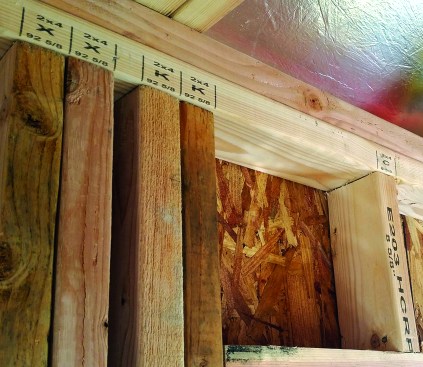
BMC’s ReadyFrame provides lumber packages with precut plates, jack studs, headers, and cripples. Plates come printed with each wall layout, so framers only have to grab precut studs from a pile and assemble the wall; no layout or cutting required.
BMC’s ReadyFrame is one option. A builder hands a BMC supplier a set of framing plans and gets back an annotated set with letters and numbers added to each wall. The builder also gets a truckload of wall plates, jack studs (known by many framers as “trimmers”), cripples, and headers. “You now get everything precut, not just full-length studs,” explains Matt Risinger.
The components for each ReadyFrame wall are banded together and labeled to match the letters and numbers on the plans. Wall plates have layouts premarked with an inkjet printer. All the framer has to do is break the banding on the wall sets and assemble the pieces, pulling full-length precuts off a separate pallet. Austin, Texas-based builder Luke Mezger, who completed a number of ReadyFrame houses in the past year, describes in visceral terms the transformation of the jobsite when using ReadyFrame: “It’s an eerie sound on the jobsite when you’re used to a lot of saws going on; all you hear is nail guns going off.”
Not having to cut components increases the speed of assembling the frame (estimates range from 15% to as much as 40% faster, depending on the complexity of the wall). It’s also safer and simpler, involves zero cutting waste, and requires less skill. Often, the most experienced person on the crew will mark-out the plate layout while other workers cut the headers, jacks, and cripples. All of the time and the skill required to complete those steps accurately is completely removed.
An increasing number of lumber retailers now work with component manufacturers to deliver preframed walls, along with roof and floor trusses. The trend is growing as more builders are using software to optimize their framing packages and interface directly with the supply chain.
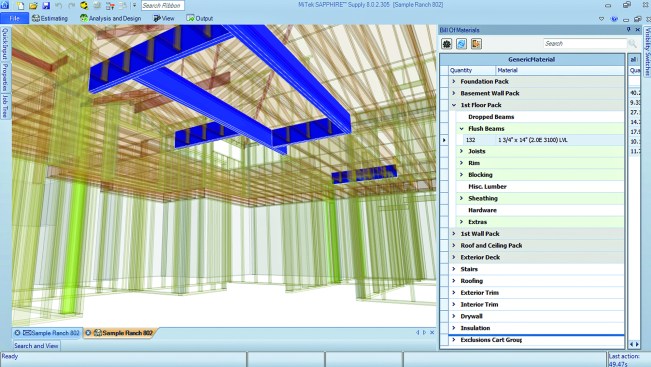
Known as BIM to BOM, Mitek’s Sapphire can generate a 3D “BIM” model from a 2D set of plans drawn in another program; optimize the framing; make sure it meets local building codes; and spit out a bill of materials (BOM) to shop with suppliers.
Although most builders lack the labor needed to fully optimize their framing, Ellis believes that a BIM-enabled CAD program like Revit can help. “You can set it up so that when you draw a wall, it tells you exactly what’s in the wall,” he says. That data can then be integrated with the builder’s estimating software.
Another option is offered by MiTek’s Sapphire suite, a BIM-based system for designing and optimizing wood frames. According to Brian McCormick, MiTek’s director for residential supply chain, the software lays out all framing according to user-defined rules and produces a bill of materials as well as a cut list for the framer.
Ultimately, MiTek’s goal is to move builders toward using more manufactured components. The company already makes the saws used by many truss and panelized-housing plants, as well as the software used to run those plants. The company recently added a framing module to Sapphire that will generate a BIM model from a 2D set of plans drawn in another program, optimize the framing, and make sure it meets local building codes. The builder can then transmit the BIM model directly to a truss or panel manufacturer.
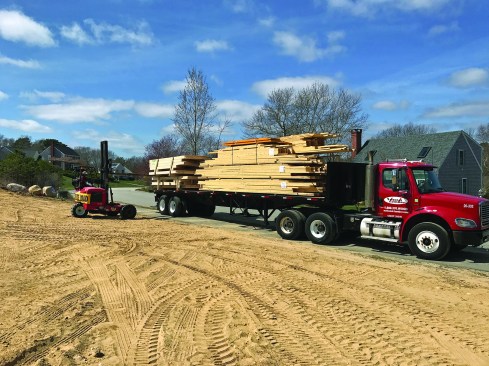
Rebooting the Framing Process
Some industry players believe that market forces and improved software will inevitably make manufactured housing the norm; as a result, they are putting design, engineering, and manufacturing under one roof.
Those market forces include builders’ labor woes. “The industry’s problem isn’t a shortage of labor but a shortage of efficient processes,” insists Gerry McCaughey, CEO of Entekra, a Ripon, Calif., startup that serves the Bay Area, Sacramento, and Central Valley markets. “North America is the only place where people still build on site. It’s as if the last 100 years didn’t happen.” McCaughey is the former head of Ireland’s Century Homes, which he grew into one of Europe’s largest home manufacturers. He believes the off-site model can revolutionize the U.S. housing market the way Amazon revolutionized retail.
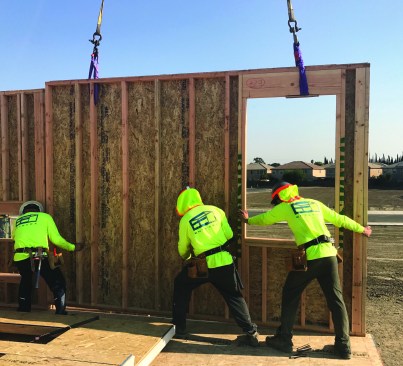
Entekra has begun piloting “fully-integrated off-site solutions” in the U.S. that promise fully assembled, weathertight building shells within four to five days, on average.
He also insists that Entekra is not just a panelizer. “We’re an engineering company. We don’t exist to make components but to look for the fastest, most efficient way to get the building up.” He says that his company’s process allows a builder to erect a house in one-third the time and with half the workers that conventional framing requires. “Our approach is so efficient that the existing labor force can deliver everything required.”
While Entekra employs human workers in its current plant, McCaughey refers to that as a pilot. He is raising capital for an automated operation with the type of robotic assembly lines used to make everything from pickup trucks to insulated glass units.
Entekra isn’t the only building manufacturer banking on robotics. Other North American companies running automated panel plants include Blueprint Robotics in Baltimore and HomeTechnology in Toronto. Blueprint is a new company targeting the custom-home market. It will deliver panels with insulation and mechanicals already installed.
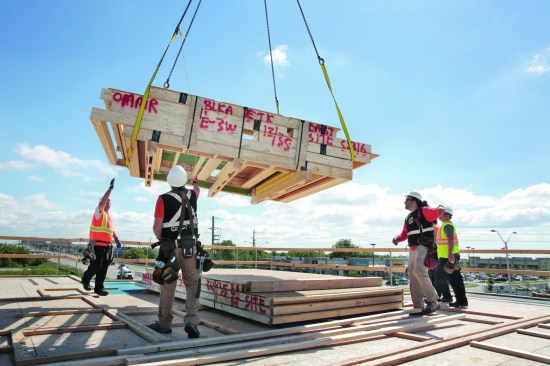
ANDREW WILLIAMSON
HomeTechnology is making inroads to North American housing markets with fully assembled floors, walls …
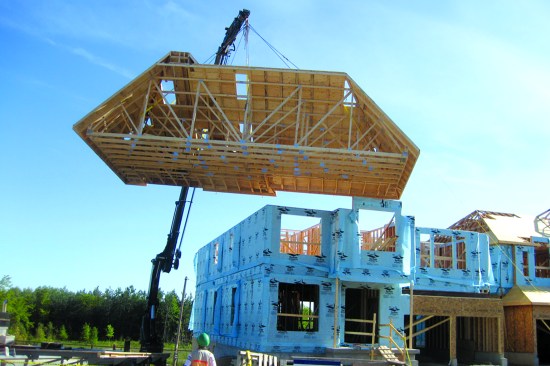
… and roofs.
HomeTechnology, a subsidiary of Great Gulf, one of Toronto’s largest developers, has an automated factory that CEO Tad Putyra says is “run by automotive people.” It has been in operation since 2008. HomeTechnology will produce more than 3 million square feet of space this year, according to Putyra. One reason he thinks the time is ripe for this approach is that software has finally become sophisticated enough to address the manufacturing issues. That includes the need to resolve all structural and mechanical conflicts at the planning stage and the need to send precise instructions to the robots and CNC machines.
The ultimate vision is a world where a buyer sits down with a designer, draws a house, and orders it over the internet. “As a model for what will likely happen to the building industry, go to Home Depot and order a kitchen,” says Scott Hedges, the North American representative for Randek, a Swedish company that makes the automated machinery that HomeTechnology uses. “The designer draws the kitchen while the computer creates manufacturing instructions and transmits them to a cabinet company in another state.”
The high-tech manufacturing approach also promises to attract a more educated workforce to the home-building industry. “The jobs we are creating are mostly in design and engineering,” Putyra notes.
There remains the question of how to justify multimillion-dollar plant investments in an industry with such large swings in demand. One answer is the route taken by HomeTechnology, which manufactures a variety of structure types—single-family and multifamily homes as well as commercial structures—for its parent company as well as for other builders and developers. Another is what Freeport, Maine-based consultant George Casey, chair of the Home Innovation Alliance, describes as a step back in time. “If you only build for-sale homes, you ride a boom-and-bust roller coaster,” he says. “But if you look back 50 years, you see builders doing for-sale and for-rent. That removed some of the fluctuation.”
Of course, some builders already do a profitable single-family-for-rent business. “Last year, approximately 25,000 detached homes were built for rent,” writes John Burns on realestateconsulting.com, his company’s website. “We believe that number will increase significantly [and] expect detached homes for rent to become an important segmentation opportunity for the top master plans in the country.”
Where it All Leads
Whether builders will continue to get on board with an increased use of manufactured components and off-site construction might largely hinge on how the labor issue plays out. What does seem clear is that some builders are not waiting for the next generation of workers to come up to speed and are seeking technological solutions using manufactured components and off-site construction. Both approaches promise to make it easier to meet code requirements and more cost-effective to build high-performance, green homes. The precision and quality control afforded can also reduce warranty costs, with the potential for the highest quality control coming from off-site methods.
The use of manufactured components is more likely to spread in rural and suburban markets where the high capital expenditure to ramp up a state-of-the-art off-site manufacturing facility will be harder to justify. Urban and high-growth markets, however, can certainly expect to see an influx of manufactured solutions and a dwindling reliance on stick-built methods.
